Source
Want more leads or conversions from your Facebook ads? Looking for successful tips for modeling your own ads?
In this article, you’ll discover eight tips for creating Facebook ads consumers respond to.
To write a message that resonates, you’ll want to dig a little deeper. Read through the comments your followers leave on your Facebook posts. Analyze the product reviews they leave on your page. Scan the posts they publish in your Facebook group.
Make note of the key phrases they repeat and the style they use. Then incorporate this customer-centric language into your Facebook ads copy. By speaking in your customers’ voice, you can more reliably connect with your target audience, giving you a better chance to get the conversions you want.
For example, @theartifox Facebook ad below references the “early mornings and late nights” that the design brand’s target audience likely experiences while working from home. The Facebook ad and instant experience both use the tagline “Create Your Dream Workspace” to reflect the audience’s interest in custom designs and tailored solutions.
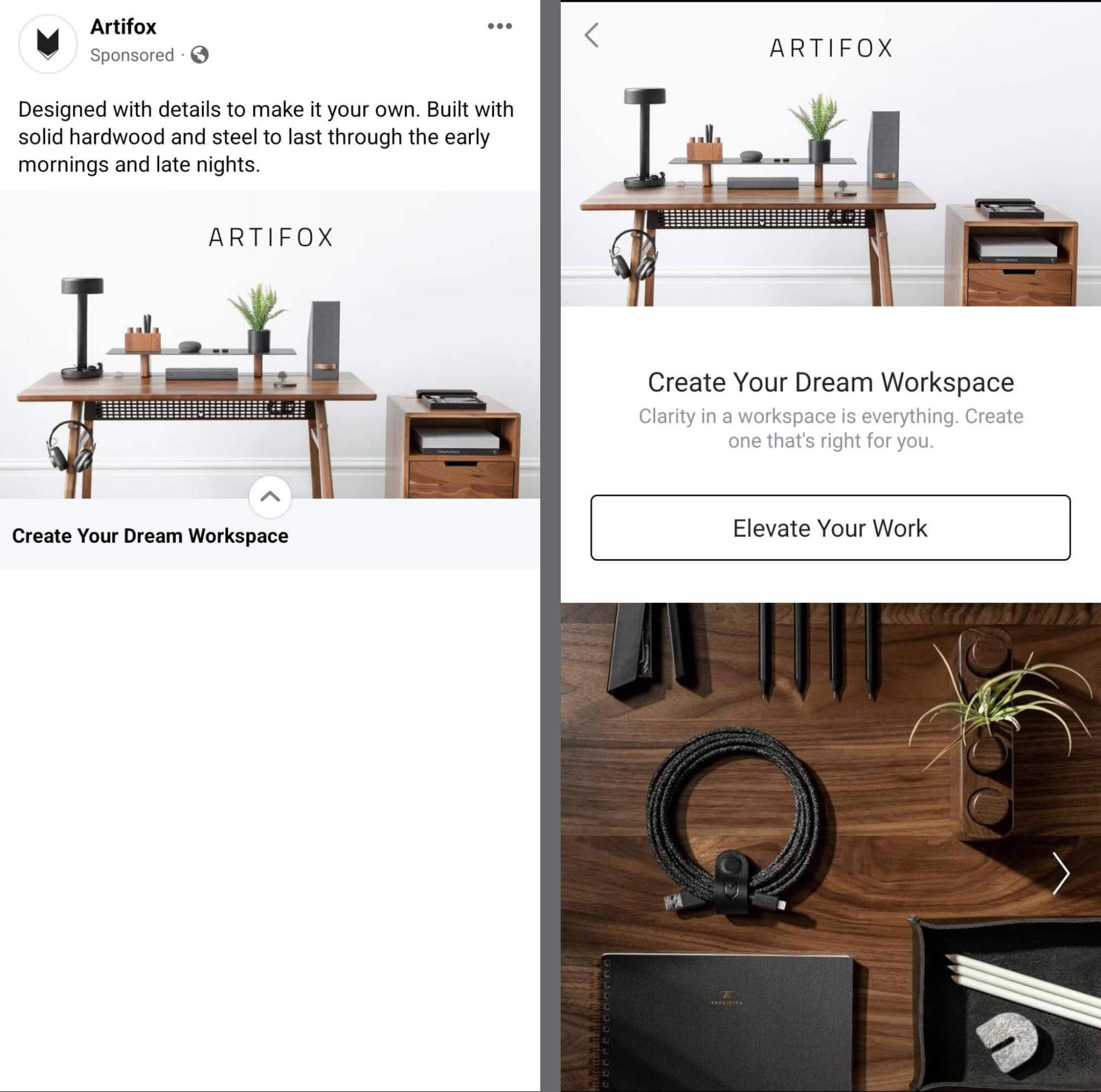
Rather than using a standard call to action (CTA) like “Shop Now,” the ad’s instant experience prompts the audience to “Elevate Your Work.” This unique CTA fits neatly with the ad’s emphasis on designing a custom home workspace.
When you write for a narrowly targeted audience, you may want to focus Facebook ads copy on a key benefit that’s essential to your customers. You may opt to create separate Facebook ads to highlight each individual selling point. But when you’re writing for a broadly targeted audience, listing multiple benefits can help you generate more interest and drive more conversions.
For example, the @Koleda.Co Facebook ad below lists three key benefits, ranging from savings on heating costs to simple phone-based controls. The ad visualizes each perk with a relevant emoji, instantly conveying the brand’s message and making the copy easier to read.
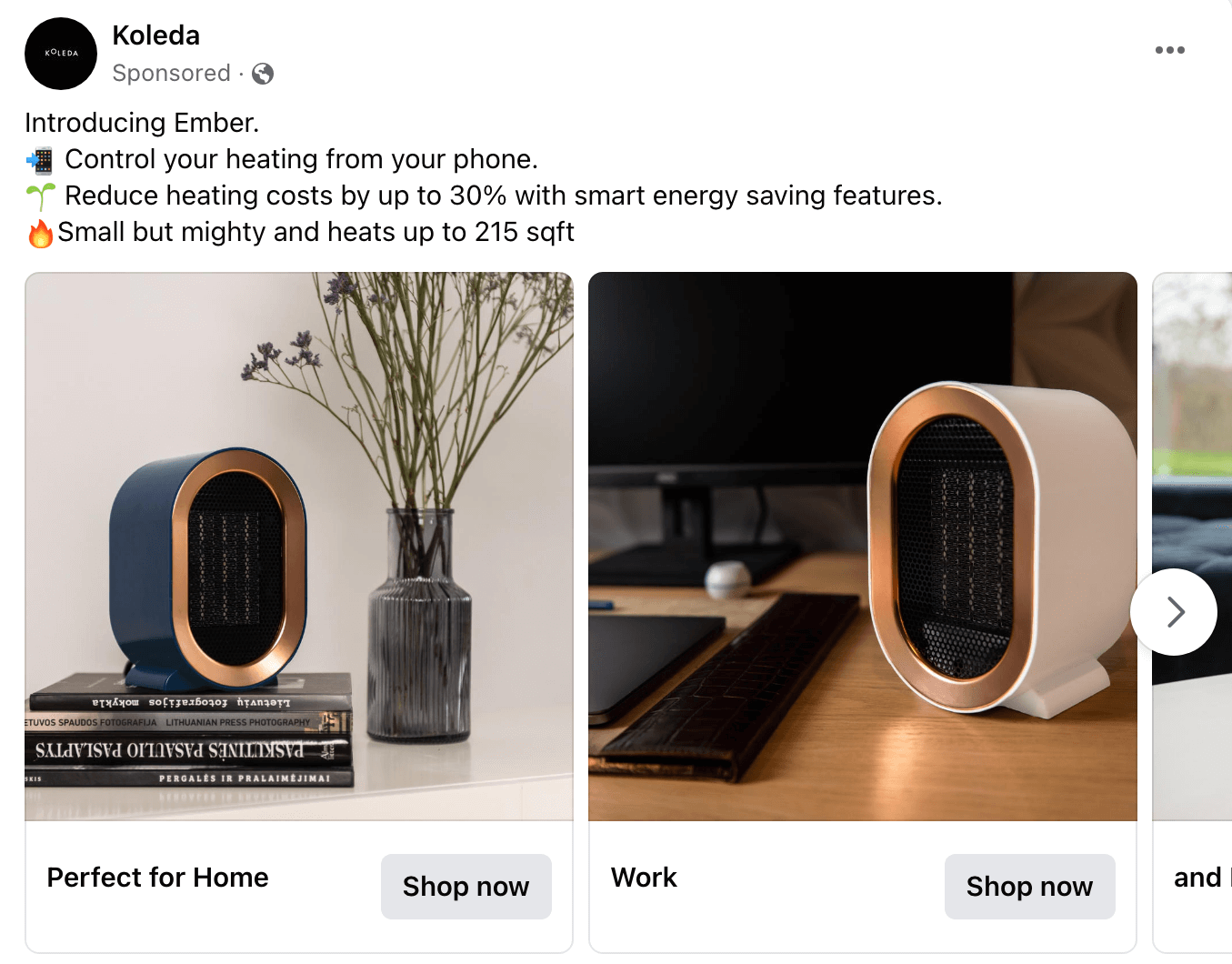
The @feltrightproducts Facebook ad below hooks prospects by referring to a common concern—“Is your space feeling a little empty?”—before seamlessly offering a solution. This ad also shares a full list of features, highlighting key phrases like “super easy installation” and “backdrop for Zoom calls,” which are likely to resonate with the home goods brand’s target audience.
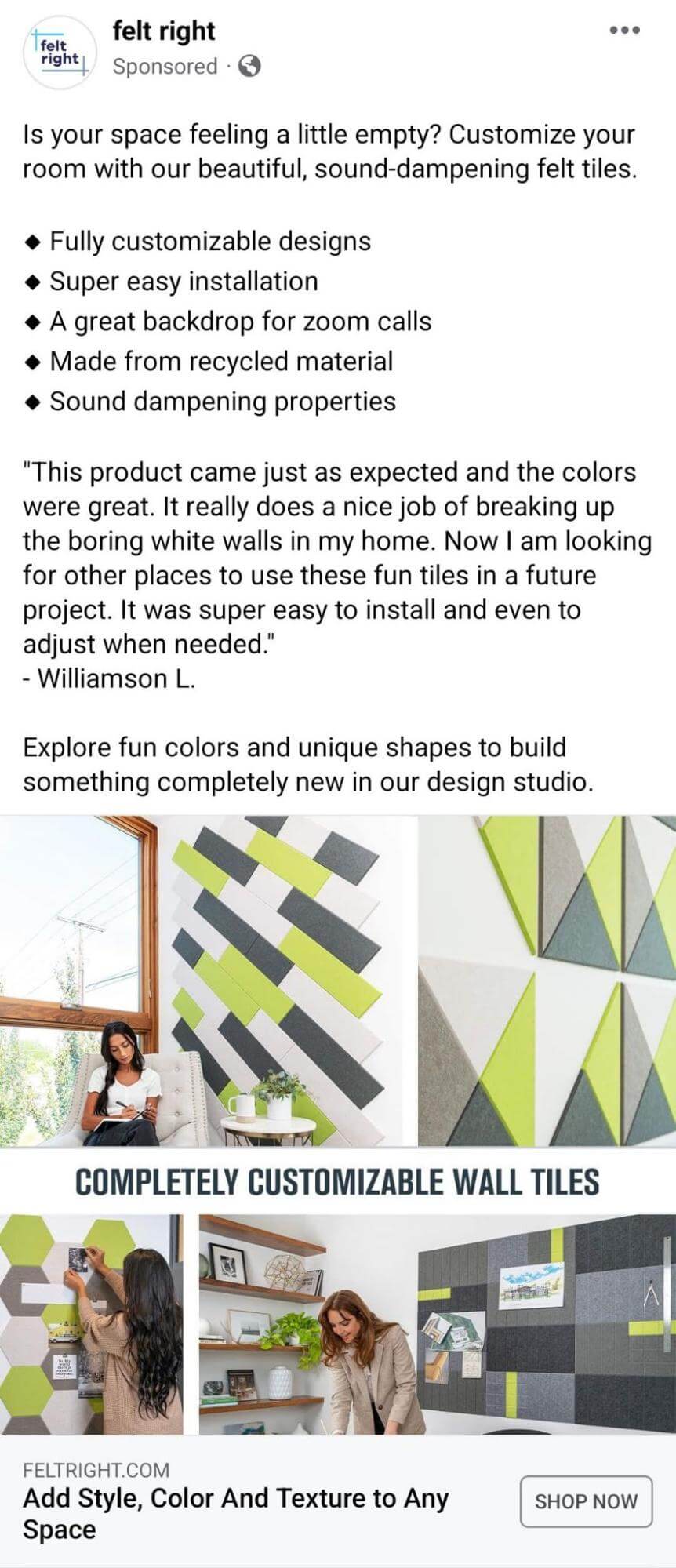
In either case, providing value for free can make your advertising funnel work smoother. When you offer freebies that your audience actually wants, you can build brand awareness, establish credibility, and make prospects more likely to spend money with your business.
Wondering what to give away? Here are a few ideas:
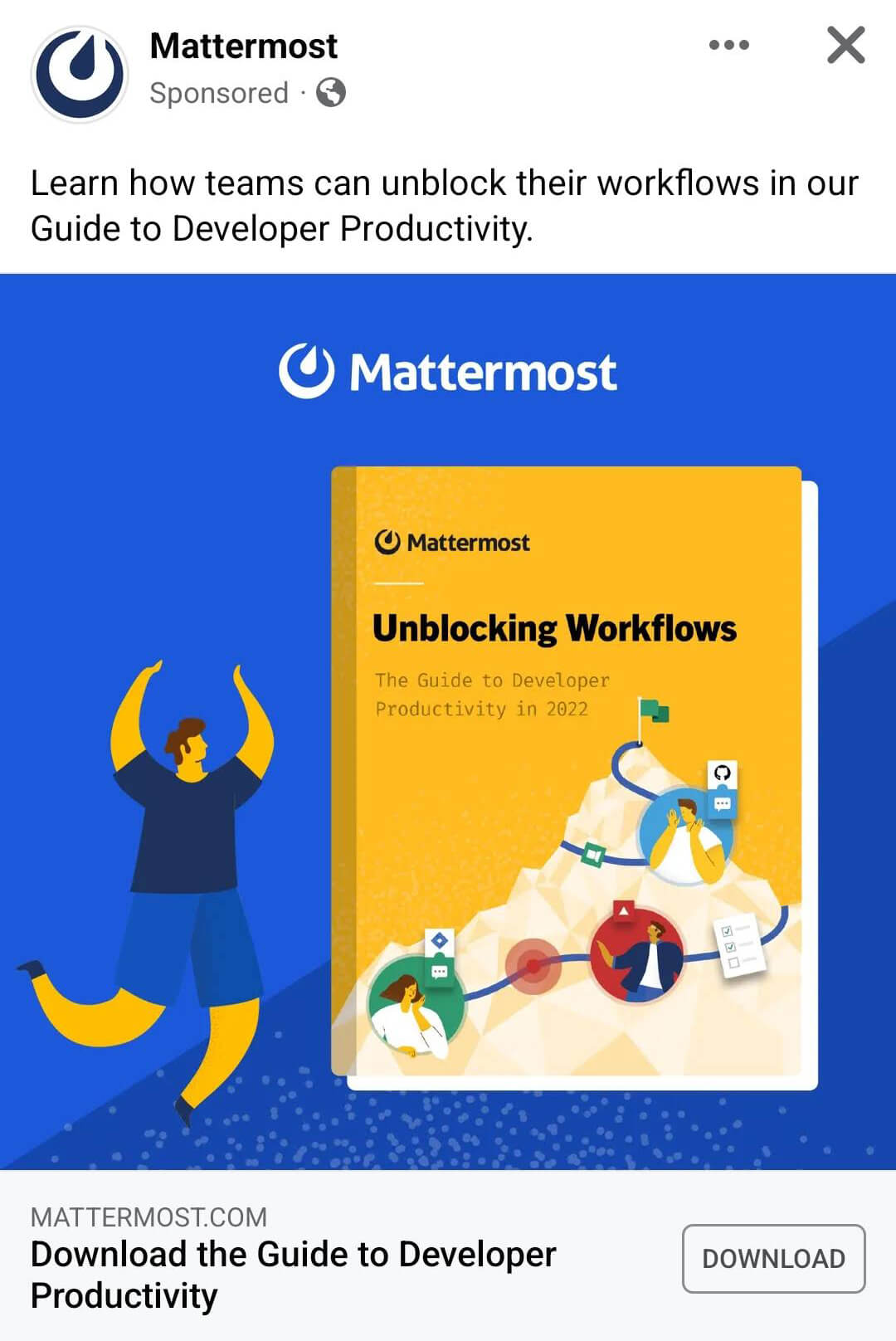
For example, the @Noissue-Creative-Community-107876128155676 Facebook ad below invites prospects to join the brand’s creative community at no cost. Since this ad uses the lead generation objective, prospects provide their contact information in exchange for access to the community.
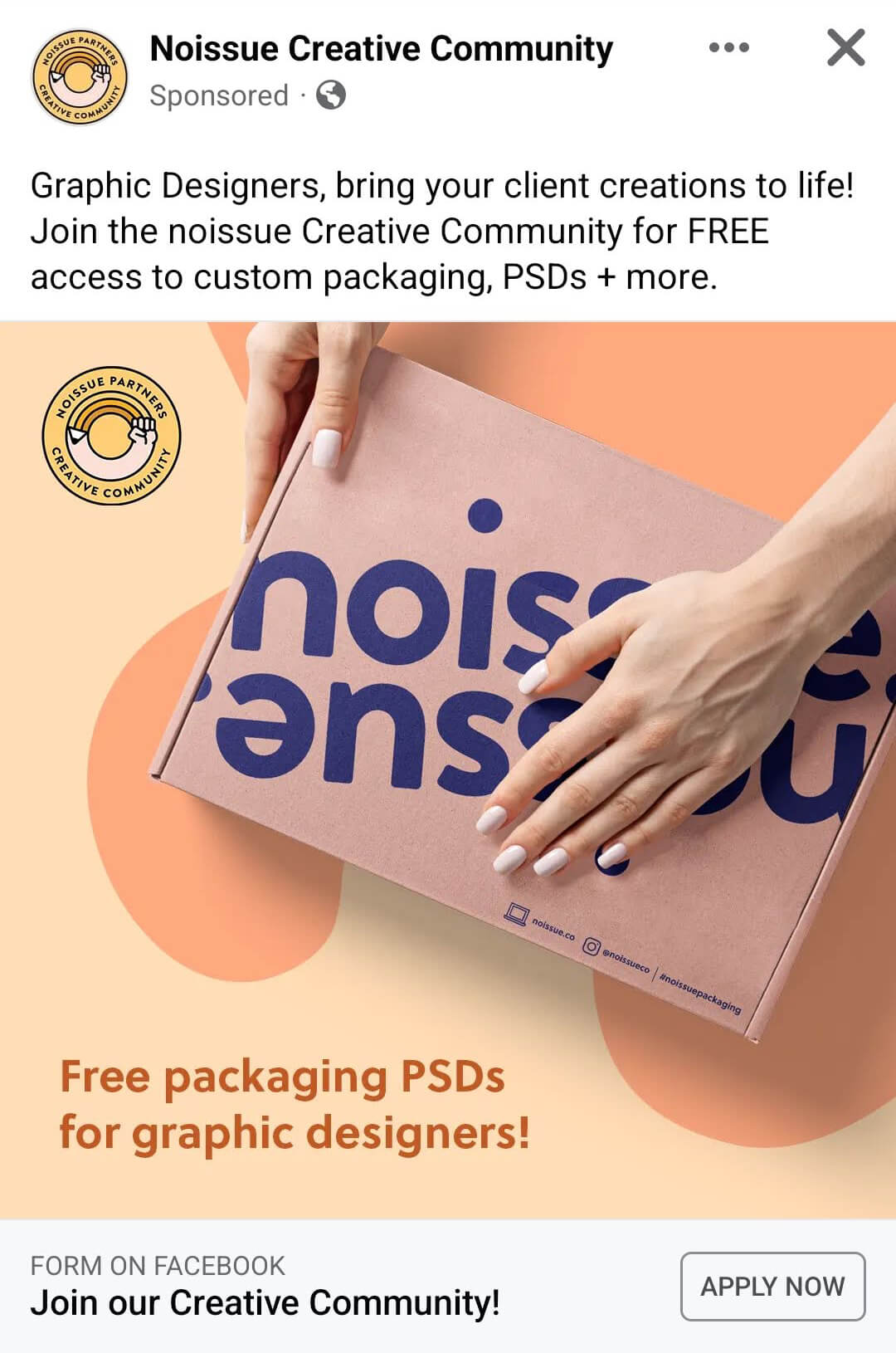
When prospects see social proof, they often feel more comfortable making the same decision others have made. Social proof can come in many different formats, including:
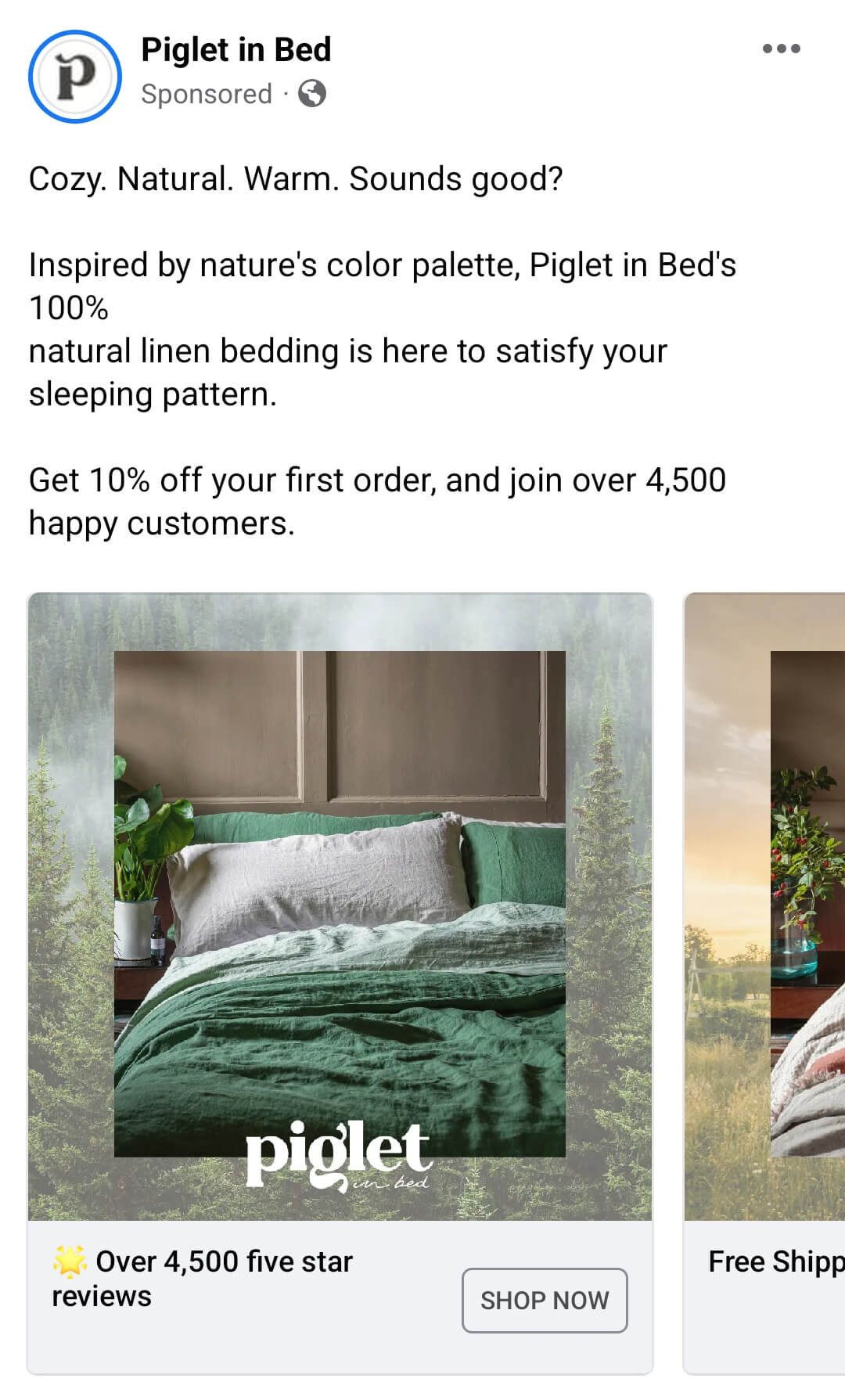
Sharing testimonials also gives you a chance to share your customers’ words directly and speak your prospects’ language more effectively. In fact, a testimonial may be all you need to write Facebook ads copy that resonates.
The @milacaresquad Facebook ad below features a customer review that highlights the stylish and functional qualities of the brand’s air purifier. The testimonial also mentions the product’s key features, which introduces the brand’s unique selling proposition (USP) from a customer’s perspective, driving conversions without appearing overly salesy.

For example, the @WeAreBrightland Facebook ad below features a short testimonial that’s just as effective. Prospects who identify with the statement “I loooveee garlic” can easily confirm that the olive oil brand’s products are right for them. The testimonial’s ending statement—“It will rock your world”—can also help prospects feel confident in their purchase and prompt them to convert.
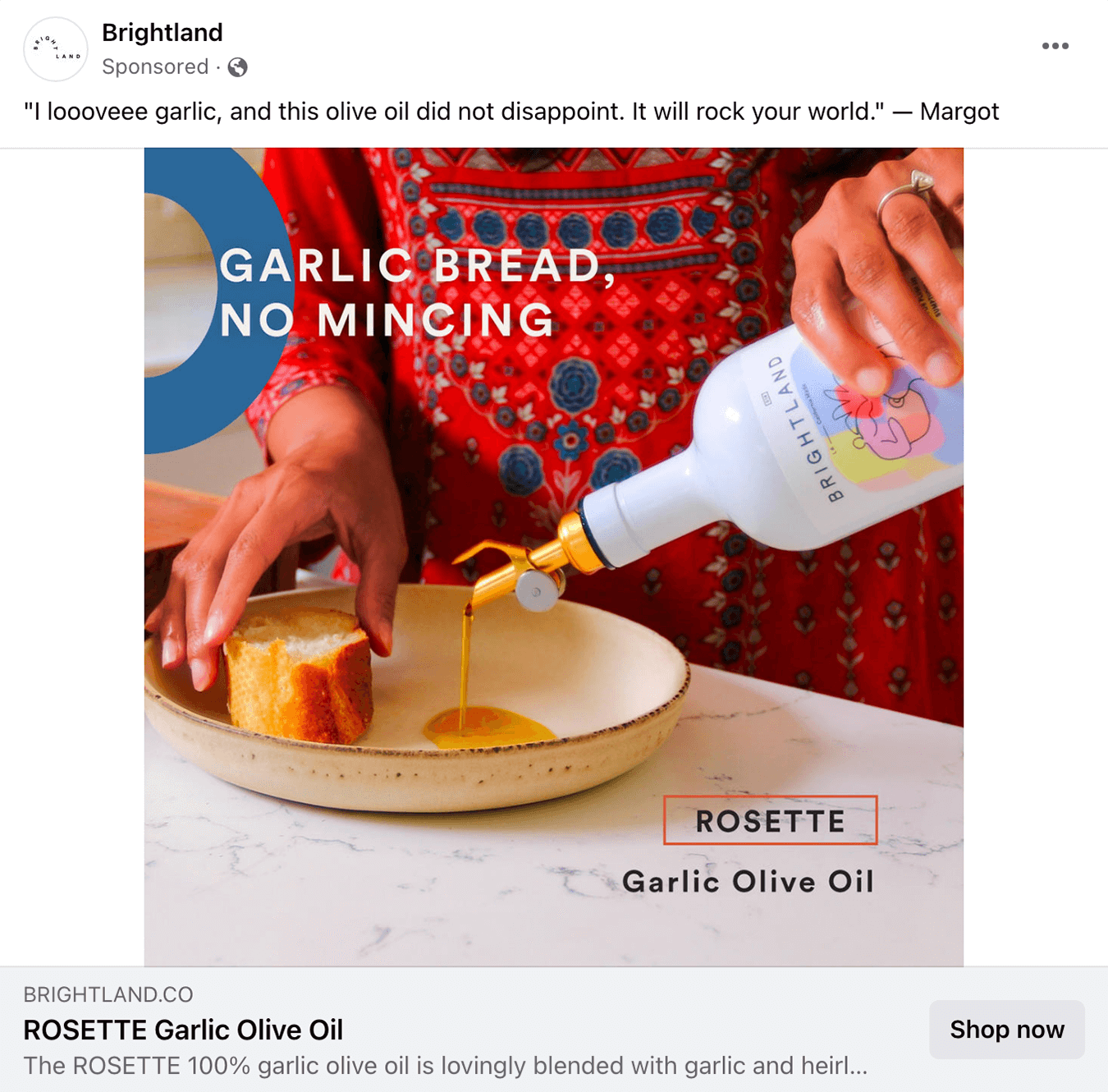

But you aren’t limited to the primary text, headline, and description fields alone. You can also add text overlays, allowing you to get your message across more effectively and drive more conversions with your creatives.
Facebook’s rule preventing text from covering more than 20% of the creative is long gone. However, it’s still a good idea to avoid too-large or excessively long text overlays. Although there’s no longer an official rule in place, Facebook reportsthat users continue to respond best to Facebook ads with text covering 20% or less of the creative.
To leverage text while keeping your audience’s preferences in mind, make your overlays count. Here are a few ideas for aligning Facebook ads copy with the creative:

The @ePOPAI Facebook ad below uses a text overlay to reiterate a key point from the copy. “Make an Impact With Every Purchase” serves as a headline designed to capture attention and drive more conversions.
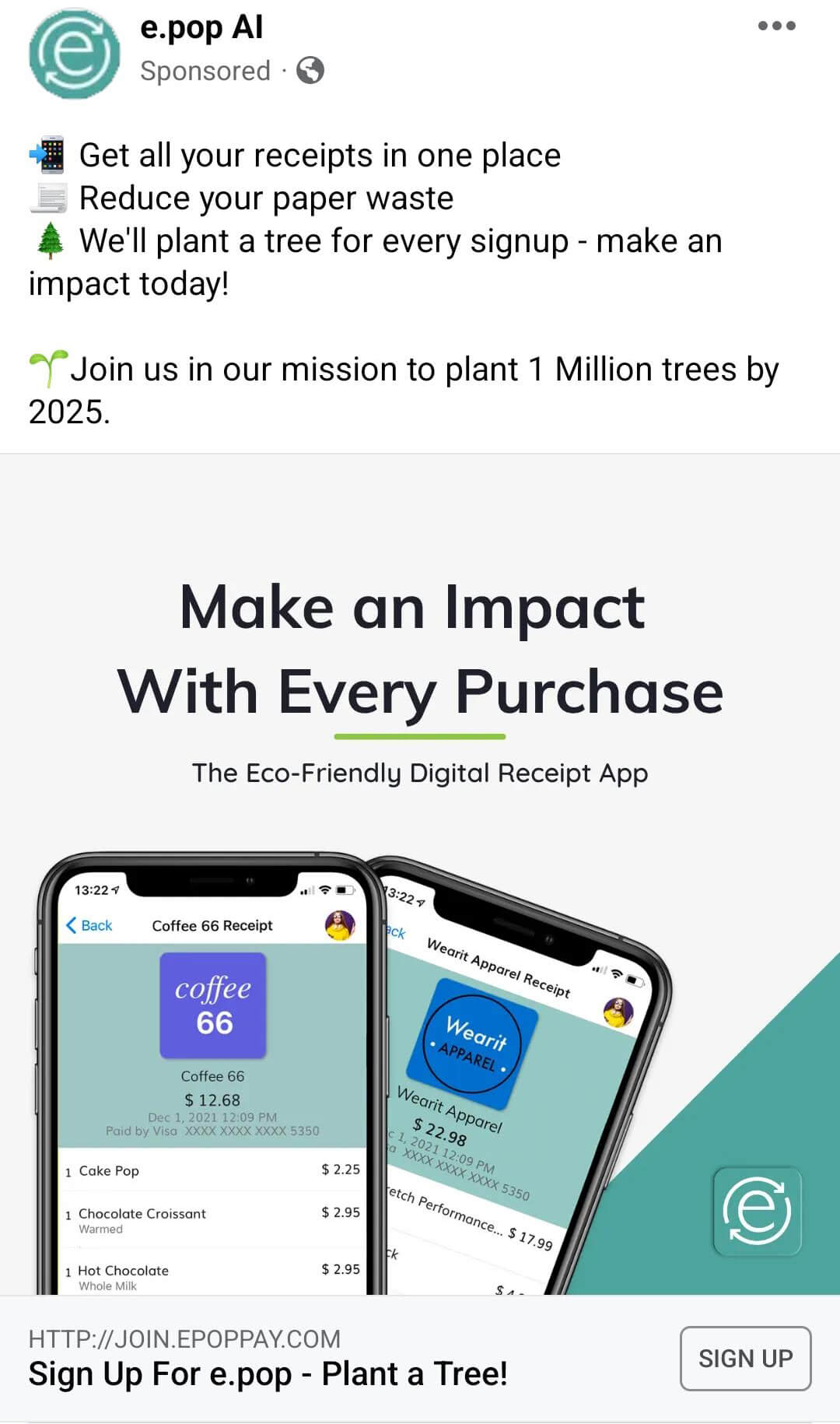
But even if you’re advertising to a relatively niche audience, your prospects are likely to have a wide range of responses to your Facebook ads. The fear of missing out may get some people to convert, while others may be more moved by your social proof. Some may respond to emojis in the primary text, while others may prefer to see them in the headline.
Rather than testing dozens of iterations, you can let the Facebook algorithm determine how to arrange your ad copy for maximum conversions. When you switch on the Optimize Text Per Person option at the ad level, you allow Facebook to shift text between fields as necessary.

That may mean your headline could land in the description field. It may also mean that your primary text ends up as a headline. Since you can also add up to five options per field, this setting lets you try numerous different iterations on your audience without having to run a dozen different Facebook ads.
But there is a downside. Ads Manager won’t necessarily tell you which combination of options or field placements generated the best results. That means you may not be able to identify the conversion techniques that work best on your audience, unless the iterations you use include relatively minor differences.
For example, it can change the aspect ratio, add filters, or increase the brightness of your image. Once your Facebook ads have comments, Facebook may automatically display the most relevant ones to improve outcomes. The algorithm automatically optimizes your Facebook ad for each person to maximize conversions.
To set up these type of Facebook ads, check the Dynamic Experiences box at the ad level. Then upload an image or video and write primary text, headline, and description text. For best results, write copy that the algorithm can place in more than one field.
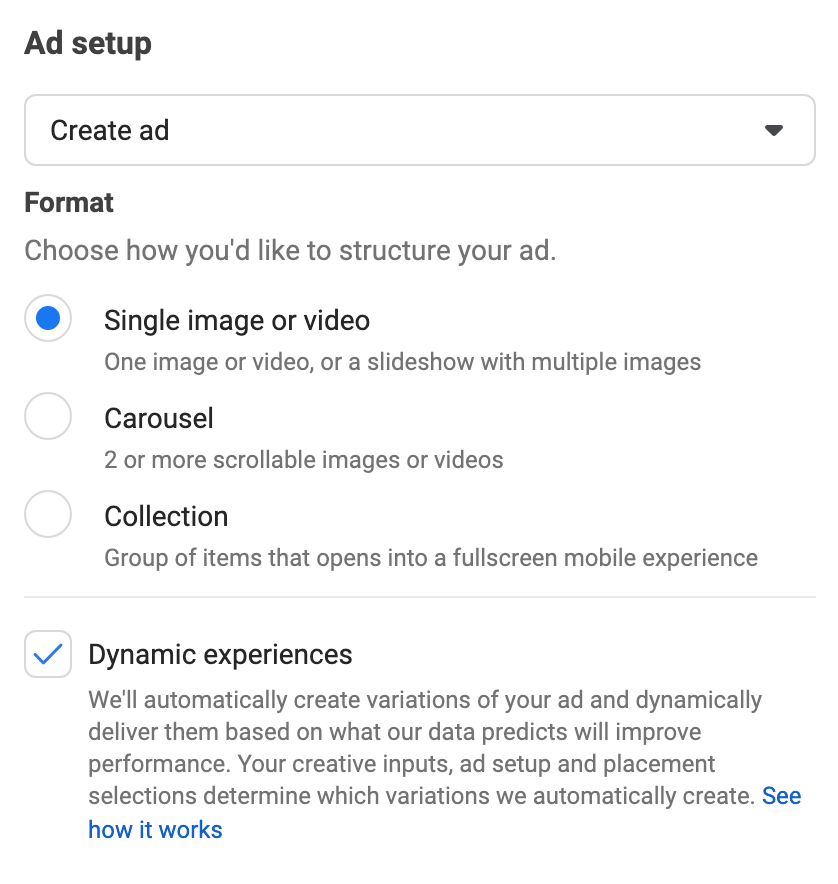
Note that the Dynamic Experiences setting has similar disadvantages as the Optimize Text Per Person feature. Both can help you get more conversions via automated optimization. But you can’t expect detailed breakdowns of the top-performing combinations of Facebook ad elements.
Want more leads or conversions from your Facebook ads? Looking for successful tips for modeling your own ads?
In this article, you’ll discover eight tips for creating Facebook ads consumers respond to.
Compare Your Existing Facebook Audience to Your Buyer Persona
To write high-performing Facebook ads, you need to know your audience. You can use your brand’s buyer persona to clarify the basics:- What’s your target demographic?
- Where does your audience live and work?
- What are your customers’ interests and beliefs?
- What are your customers’ needs and challenges?
To write a message that resonates, you’ll want to dig a little deeper. Read through the comments your followers leave on your Facebook posts. Analyze the product reviews they leave on your page. Scan the posts they publish in your Facebook group.
Make note of the key phrases they repeat and the style they use. Then incorporate this customer-centric language into your Facebook ads copy. By speaking in your customers’ voice, you can more reliably connect with your target audience, giving you a better chance to get the conversions you want.
For example, @theartifox Facebook ad below references the “early mornings and late nights” that the design brand’s target audience likely experiences while working from home. The Facebook ad and instant experience both use the tagline “Create Your Dream Workspace” to reflect the audience’s interest in custom designs and tailored solutions.

Rather than using a standard call to action (CTA) like “Shop Now,” the ad’s instant experience prompts the audience to “Elevate Your Work.” This unique CTA fits neatly with the ad’s emphasis on designing a custom home workspace.
#1: Highlight Product Features and Benefits
The more you know about your target audience, the better you can understand their challenges and goals, which allows you to write more compelling Facebook ads copy. Using these insights into their goals, you can align the features and benefits your product offers with the goals your audience wants to achieve.When you write for a narrowly targeted audience, you may want to focus Facebook ads copy on a key benefit that’s essential to your customers. You may opt to create separate Facebook ads to highlight each individual selling point. But when you’re writing for a broadly targeted audience, listing multiple benefits can help you generate more interest and drive more conversions.
For example, the @Koleda.Co Facebook ad below lists three key benefits, ranging from savings on heating costs to simple phone-based controls. The ad visualizes each perk with a relevant emoji, instantly conveying the brand’s message and making the copy easier to read.

The @feltrightproducts Facebook ad below hooks prospects by referring to a common concern—“Is your space feeling a little empty?”—before seamlessly offering a solution. This ad also shares a full list of features, highlighting key phrases like “super easy installation” and “backdrop for Zoom calls,” which are likely to resonate with the home goods brand’s target audience.

#2: Provide Value at No Cost
In some cases, your product’s benefits may be compelling enough for your audience to convert instantly. But in other cases, you may need to set up a series of smaller interactions before you can complete the final conversion. For example, you may need to get a new audience to trust your brand, or you may need to warm up your audience before pitching a high-value item.In either case, providing value for free can make your advertising funnel work smoother. When you offer freebies that your audience actually wants, you can build brand awareness, establish credibility, and make prospects more likely to spend money with your business.
Wondering what to give away? Here are a few ideas:
- Lead magnets like eBooks, white papers, case studies, and guides can include valuable research and educate prospects about a key topic.
- Downloadable checklists and templates give prospects materials they can start using to address challenges right away.
- Trials, demos, and subscriptions allow prospects to join your community or test your product before buying.

For example, the @Noissue-Creative-Community-107876128155676 Facebook ad below invites prospects to join the brand’s creative community at no cost. Since this ad uses the lead generation objective, prospects provide their contact information in exchange for access to the community.

#3: Share Social Proof
Providing free resources isn’t the only way to increase customer trust in your brand and secure the conversions you want. Social proof indicates that others—name-brand companies, respected industry figures, or large numbers of fellow consumers—have bought from your brand.When prospects see social proof, they often feel more comfortable making the same decision others have made. Social proof can come in many different formats, including:
- Logos of brands that use your products
- Celebrity or influencer endorsements
- Total number of customers you’ve served

#4: Reuse Customer Testimonials
Customer tallies can be compelling, but in some cases, customer reviews may be even more convincing. Studies have shown that more than 90% of customers trust reviews and put as much stock in them as they would in a recommendation from a friend.Sharing testimonials also gives you a chance to share your customers’ words directly and speak your prospects’ language more effectively. In fact, a testimonial may be all you need to write Facebook ads copy that resonates.
The @milacaresquad Facebook ad below features a customer review that highlights the stylish and functional qualities of the brand’s air purifier. The testimonial also mentions the product’s key features, which introduces the brand’s unique selling proposition (USP) from a customer’s perspective, driving conversions without appearing overly salesy.

For example, the @WeAreBrightland Facebook ad below features a short testimonial that’s just as effective. Prospects who identify with the statement “I loooveee garlic” can easily confirm that the olive oil brand’s products are right for them. The testimonial’s ending statement—“It will rock your world”—can also help prospects feel confident in their purchase and prompt them to convert.

#5: Offer a Limited-Time Discount
You may want customers to make a purchase or submit a lead form right away. But your prospects may prefer to think it over and make a decision later. How can you prompt them to convert faster? Here are a couple of ideas:- Make a time-sensitive offer that won’t last long. State the expiration date so customers know they need to take advantage before it’s gone.
- Showcase an item that’s only available in limited quantities. Let prospects know that only a few are available to create a fear of missing out.

#6: Align Copy With Creative
Facebook gives advertisers ample space to write compelling copy. The primary text field displays 125 characters and can include hundreds more behind the See More button, while the headline and description fields can support up to 25 and 30 characters, respectively.But you aren’t limited to the primary text, headline, and description fields alone. You can also add text overlays, allowing you to get your message across more effectively and drive more conversions with your creatives.
Facebook’s rule preventing text from covering more than 20% of the creative is long gone. However, it’s still a good idea to avoid too-large or excessively long text overlays. Although there’s no longer an official rule in place, Facebook reportsthat users continue to respond best to Facebook ads with text covering 20% or less of the creative.
To leverage text while keeping your audience’s preferences in mind, make your overlays count. Here are a few ideas for aligning Facebook ads copy with the creative:
- Reiterate the most important point from your ad copy.
- Highlight a major benefit that didn’t fit with the copy.
- Feature an attention-grabbing tagline.

The @ePOPAI Facebook ad below uses a text overlay to reiterate a key point from the copy. “Make an Impact With Every Purchase” serves as a headline designed to capture attention and drive more conversions.

#7: Turn On Optimize Text Per Person
If you’re serious about Facebook ads, then you probably spend a ton of time perfecting your copy. Naturally, you want to get it just right and understand exactly what resonates with your audience so you can replicate the formula in future campaigns.But even if you’re advertising to a relatively niche audience, your prospects are likely to have a wide range of responses to your Facebook ads. The fear of missing out may get some people to convert, while others may be more moved by your social proof. Some may respond to emojis in the primary text, while others may prefer to see them in the headline.
Rather than testing dozens of iterations, you can let the Facebook algorithm determine how to arrange your ad copy for maximum conversions. When you switch on the Optimize Text Per Person option at the ad level, you allow Facebook to shift text between fields as necessary.

That may mean your headline could land in the description field. It may also mean that your primary text ends up as a headline. Since you can also add up to five options per field, this setting lets you try numerous different iterations on your audience without having to run a dozen different Facebook ads.
But there is a downside. Ads Manager won’t necessarily tell you which combination of options or field placements generated the best results. That means you may not be able to identify the conversion techniques that work best on your audience, unless the iterations you use include relatively minor differences.
#8: Enable Dynamic Experiences
To give the Facebook algorithm even more options for optimizing your Facebook ads, create a dynamic experience. With this setting enabled, Facebook can combine text in various ways and modify your creative to get better results in a particular placement.For example, it can change the aspect ratio, add filters, or increase the brightness of your image. Once your Facebook ads have comments, Facebook may automatically display the most relevant ones to improve outcomes. The algorithm automatically optimizes your Facebook ad for each person to maximize conversions.
To set up these type of Facebook ads, check the Dynamic Experiences box at the ad level. Then upload an image or video and write primary text, headline, and description text. For best results, write copy that the algorithm can place in more than one field.

Note that the Dynamic Experiences setting has similar disadvantages as the Optimize Text Per Person feature. Both can help you get more conversions via automated optimization. But you can’t expect detailed breakdowns of the top-performing combinations of Facebook ad elements.



